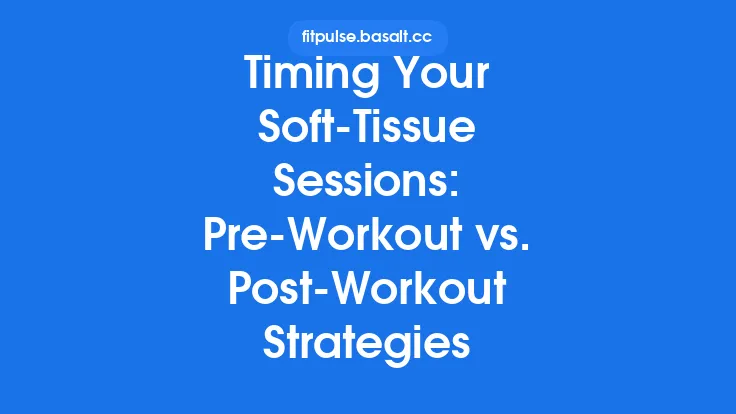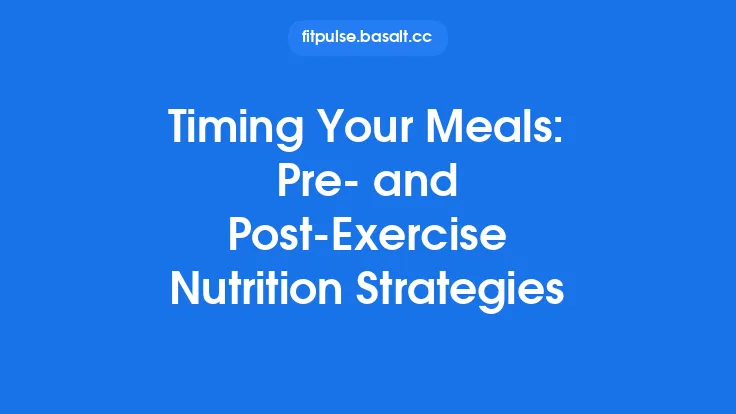Dynamic stretching is often thought of as a simple warm‑up activity, but its optimal timing can be far more nuanced. By strategically placing dynamic movements before, during, and after a training session, athletes and recreational exercisers can harness distinct physiological windows that support performance, maintain movement quality, and facilitate a smoother transition into recovery. This article explores the evidence‑based rationale for each timing window, outlines practical guidelines for implementation, and offers tools for monitoring effectiveness—all while keeping the focus on the “when” rather than the “how” of specific stretch selections.
Pre‑Workout Dynamic Stretching: Setting the Stage
1. Physiological priming
During the minutes leading up to a training bout, the body undergoes a cascade of acute responses: core temperature rises, blood flow to active muscles increases, and the nervous system shifts toward a higher firing rate. Dynamic stretches that involve controlled, sport‑specific ranges of motion amplify these responses by:
- Elevating muscle temperature – each repetition generates internal friction, raising tissue temperature by 1–2 °C, which improves enzymatic activity and reduces viscosity of the muscle‑tendon unit.
- Enhancing motor unit recruitment – the rapid, purposeful movement patterns stimulate gamma‑motor neurons, sharpening proprioceptive feedback and preparing the stretch reflex for the upcoming load.
- Boosting hormonal milieu – brief bouts of dynamic activity elevate circulating catecholamines (epinephrine, norepinephrine), which can improve power output and mental alertness.
2. Timing parameters
Research suggests that a 5‑ to 10‑minute dynamic segment performed immediately before the main effort yields the greatest performance benefit. The segment should be:
| Parameter | Recommended Range | Rationale |
|---|---|---|
| Duration per movement | 8–12 repetitions or 20–30 seconds | Sufficient to elicit temperature rise without inducing fatigue |
| Intensity | Moderate (≈40‑60 % of maximal effort) | Balances activation with preservation of energy stores |
| Rest between movements | 10‑15 seconds | Allows brief neural reset while maintaining elevated core temperature |
3. Integration with other warm‑up components
Dynamic stretches are most effective when sequenced after general aerobic activation (e.g., 3‑5 minutes of light cycling) and before specific skill or load‑specific drills. This “general → dynamic → specific” progression respects the principle of progressive overload in the warm‑up context.
In‑Workout Dynamic Stretching: Maintaining Momentum
1. Why stretch mid‑session?
Traditional training protocols often treat the warm‑up as a one‑off event, but the body’s physiological state can regress during prolonged sessions, especially in high‑volume or interval‑based workouts. In‑workout dynamic stretching serves three primary purposes:
- Re‑establishing range of motion that may diminish due to muscular fatigue or repetitive loading.
- Sustaining neuromuscular activation by periodically refreshing proprioceptive input.
- Facilitating active recovery between sets, helping to clear metabolic by‑products while keeping the muscles engaged.
2. Optimal windows for insertion
The most effective moments to insert dynamic stretches are:
- Between supersets or compound‑exercise clusters – a 30‑second dynamic movement can act as a low‑intensity active rest, preserving heart‑rate elevation without adding significant metabolic load.
- During longer rest intervals (≥90 seconds) – when the nervous system begins to down‑regulate, a brief dynamic set can maintain cortical arousal.
- At the transition between training modalities – for example, moving from a strength block to a conditioning circuit.
3. Practical dosage
A concise in‑workout dynamic segment typically consists of 1‑2 movements performed for 10‑15 repetitions or 15‑20 seconds. The intensity should be low enough to avoid compromising subsequent performance (≈20‑30 % effort). Because the goal is to preserve overall training volume, the total time dedicated to in‑workout dynamic stretching rarely exceeds 2‑3 minutes per session.
4. Compatibility with load management
When training for maximal strength or power, it is crucial to monitor any potential interference with subsequent lifts. Studies indicate that dynamic movements performed at low intensity do not significantly affect subsequent 1‑RM performance, provided the total volume remains modest. However, for athletes operating near the edge of their capacity, a brief “dynamic pause” (e.g., leg swings) can be substituted with passive rest if any performance decrement is observed.
Post‑Workout Dynamic Stretching: Transitioning to Recovery
1. The role of movement after exertion
Post‑exercise, the body shifts toward a catabolic state, with elevated lactate, hydrogen ions, and inflammatory mediators. While static stretching is traditionally recommended for cool‑down, a short, low‑intensity dynamic routine can complement recovery by:
- Promoting venous return – rhythmic limb movements act as a muscle pump, accelerating clearance of metabolic waste.
- Re‑establishing neuromuscular balance – gentle dynamic motions help reset altered firing patterns that may have arisen during high‑intensity work.
- Facilitating a smoother autonomic transition – moving from sympathetic dominance toward parasympathetic activation can be aided by controlled, flowing movements.
2. Timing and structure
A 3‑ to 5‑minute dynamic cool‑down performed within the first 5‑10 minutes after the final set is optimal. The protocol should:
- Lower intensity to ≤20 % of maximal effort – ensuring the activity remains restorative.
- Focus on full‑range, slow‑controlled motions – such as arm circles, hip hinges, or ankle pumps.
- Incorporate breathing cues – synchronizing movement with diaphragmatic breathing enhances parasympathetic activation.
3. Interaction with other recovery modalities
Dynamic post‑workout movements can be paired with foam‑rolling, contrast showers, or nutritional interventions without conflict. The key is to keep the dynamic component brief and low‑intensity so it does not counteract the intended relaxation effect of subsequent recovery strategies.
Integrating Timing Strategies into Periodized Programs
1. Macro‑cycle considerations
Across a training year, the emphasis on each timing window can be shifted to align with specific phases:
| Phase | Primary Timing Focus | Rationale |
|---|---|---|
| Preparatory (general) | Pre‑workout dynamic (longer, higher intensity) | Build baseline activation and movement competency |
| Preparatory (specific) | Pre‑ + In‑workout dynamic | Refine sport‑specific patterns and maintain range during high volume |
| Peak / Competition | Pre‑workout dynamic (brief, highly specific) + In‑workout dynamic (minimal) | Preserve performance while minimizing fatigue |
| Transition / Off‑season | Post‑workout dynamic (emphasis) | Aid recovery and promote mobility maintenance |
2. Micro‑cycle (weekly) adjustments
Within a given week, the distribution of dynamic timing can be modulated based on session density:
- Heavy‑load days – prioritize concise pre‑workout dynamic; limit in‑workout and post‑workout dynamic to avoid cumulative fatigue.
- Conditioning or skill days – incorporate longer in‑workout dynamic segments to sustain movement quality.
- Recovery days – expand post‑workout dynamic duration, possibly merging with mobility circuits.
3. Monitoring tools
To ensure the timing strategy is delivering the intended benefits, practitioners can track:
- Heart‑rate variability (HRV) – a rise in HRV post‑session may indicate effective autonomic recovery, potentially enhanced by post‑workout dynamic work.
- Range‑of‑motion (ROM) assessments – periodic goniometric or functional tests can reveal whether in‑workout dynamic stretches are preserving mobility across a training block.
- Performance metrics – compare set‑by‑set power output or velocity before and after implementing in‑workout dynamic pauses.
Practical Tips for Implementing Timing Protocols
- Start with a baseline – record a typical warm‑up, intra‑session, and cool‑down routine for a week. Note perceived fatigue, performance, and recovery quality.
- Introduce one timing change at a time – e.g., add a 30‑second dynamic pause between supersets. Observe the impact before layering additional modifications.
- Use a timer or metronome – precise timing helps maintain the intended intensity and prevents the dynamic segment from unintentionally becoming a secondary workout.
- Tailor movement selection to the training goal – while avoiding detailed exercise prescriptions, ensure the dynamic pattern mirrors the joint actions of the primary lifts or drills.
- Educate athletes on the “why” – understanding the physiological purpose of each timing window improves adherence and reduces the temptation to skip or overdo the stretches.
Common Misconceptions and How to Avoid Them
| Misconception | Reality | Practical Fix |
|---|---|---|
| “Dynamic stretching is only for warm‑ups.” | Dynamic movements can be beneficial at any point in a session when applied appropriately. | Schedule brief, low‑intensity dynamic sets during long rests or after the final set. |
| “Long, intense dynamic stretches improve flexibility post‑workout.” | High‑intensity dynamic work after training can prolong sympathetic activation and delay recovery. | Keep post‑workout dynamic movements slow, controlled, and under 20 % effort. |
| “If I’m doing a dynamic warm‑up, I don’t need any other activation.” | Dynamic stretches complement, but do not replace, other activation methods such as band work or motor‑control drills. | Combine dynamic stretches with sport‑specific activation drills for a comprehensive preparation. |
| “More dynamic stretching equals better performance.” | Excess volume can lead to premature fatigue, especially before maximal strength or power efforts. | Adhere to the 5‑10 minute pre‑workout window and limit in‑session dynamic volume to ≤3 minutes. |
Concluding Thoughts
Timing is the hidden lever that transforms dynamic stretching from a generic warm‑up habit into a strategic performance tool. By aligning dynamic movements with the body’s acute physiological states—pre‑exercise activation, mid‑session maintenance, and post‑exercise transition—athletes can extract measurable gains in power output, sustain movement quality throughout demanding sessions, and promote a smoother recovery pathway. The key lies in purposeful dosage, precise placement, and ongoing monitoring, ensuring that each dynamic segment serves its intended role without encroaching on the primary training stimulus. When integrated thoughtfully into periodized programming, timing‑based dynamic stretching becomes an evergreen component of any flexibility and mobility regimen, delivering consistent benefits across training cycles and athletic pursuits.




